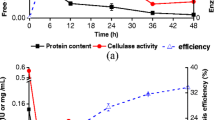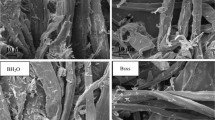Abstract
Lignin polymers in bamboo (Phyllostachys pubescens) were decomposed into polyphenols at high temperatures and oxidized for the introduction of quinone groups from peroxidase extracted from bamboo shoots and catalysis of UV. According to the results of FT-IR spectra analysis, neutral proteases (NPs) can be immobilized on the oxidized lignin by covalent bonding formed by amine group and quinone group. The optimum condition for the immobilization of NPs on the bamboo bar was obtained at pH 7.0, 40 °C, and duration of 4 h; the amount of immobilized enzyme was up to 5 mg g−1 bamboo bar. The optimal pH for both free NP (FNP) and INP was approximately 7.0, and the maximum activity of INP was determined at 60 °C, whereas FNP presented maximum activity at 50 °C. The Km values of INP and FNP were determined as 0.773 and 0.843 mg ml−1, respectively; INP showed a lower Km value and Vmax, than FNP, which demonstrated that INP presented higher affinity to substrate. Compared to FNP, INP showed broader thermal and storage stability under the same trial condition. With respect to cost, INP presented considerable recycling efficiency for up to six consecutive cycles.







Similar content being viewed by others
References
Wang, G., Xu, A., Wan, Y., & Li, Q. (2013). Purification and characterization of a new metallo-neutral protease for beer brewing from Bacillus amyloliquefaciens SYB-001. Applied Biochemistry and Biotechnology, 170(8), 2021–2033. https://doi.org/10.1007/s12010-013-0350-8
Wittrock, H., Jiang, M., Campbell, M., Jane, J., Anih, E., & Wang, E. (2008). A simplified isolation of high-amylose maize starch using neutral proteases. Starch-Stärke, 60(11), 601–608. https://doi.org/10.1002/star.200800223
Szot, G., Lee, M., Tavakol, M., Lang, J., Dekovic, F., Kerlan, R., & Posselt, A. (2009). Successful clinical islet isolation using a GMP-manufactured collagenase and neutral protease. Transplantation, 88(6), 753–756. https://doi.org/10.1097/TP.0b013e3181b443ae
Seabra, I., & Gil, M. (2007). Cotton gauze bandage: a support for protease immobilization for use in biomedical applications. Brazilian Journal of Pharmaceutical Sciences, 43, 535–542.
Gilani, S., Najafpour, G., Moghadamnia, A., & Kamaruddin, A. (2016). Stability of immobilized porcine pancreas lipase on mesoporous chitosan beads: a comparative study. Journal of Molecular Catalysis B: Enzymatic, 133, 144–153. https://doi.org/10.1016/j.molcatb.2016.08.005
Fernandez-Lopez, L., Pedrero, S., Lopez-Carrobles, N., Gorines, B., Virgen-Ortíz, J., & Fernandez-Lafuente, R. (2017). Effect of protein load on stability of immobilized enzymes. Enzyme and Microbial Technology, 98, 18–25. https://doi.org/10.1016/j.enzmictec.2016.12.002
Al-Qodah, Z., Al-Shannag, M., Al-Busoul, M., Penchev, I., & Orfali, W. (2017). Immobilized enzymes bioreactors utilizing a magnetic field: a review. Biochemical Engineering Journal, 121, 94–106. https://doi.org/10.1016/j.bej.2017.02.003
Jiang, Y., Sun, W., Wang, Y., Wang, W., Zhou, L., Gao, J., & Zhang, X. (2017). Protein-based inverse opals: a novel support for enzyme immobilization. Enzyme and Microbial Technology, 96, 42–46. https://doi.org/10.1016/j.enzmictec.2016.08.021
Liu, Y., & Chen, J. (2016). Enzyme immobilization on cellulose matrixes. Journal of Bioactive and Compatible Polymers, 31(6), 553–567. https://doi.org/10.1177/0883911516637377
Catia, A., Laura, D., & Lidietta, G. (2017). Tyrosinase immobilized on a hydrophobic membrane. Biotechnology and Applied Biochemistry, 64, 92–99.
Li, J., Du, Y., Sun, L., Liang, H., Feng, T., Wei, Y., & Yao, P. (2006). Chitosaneous hydrogel beads for immobilizing neutral protease for application in the preparation of low molecular weight chitosan and chito-oligomers. Journal of Applied Polymer Science, 101, 3742–3750.
Bavaro, T., Cattaneo, G., Serra, I., Benucci, I., Pregnolato, M., & Terreni, M. (2017). Immobilization of neutral protease from Bacillus subtilis for regioselective hydrolysis of acetylated nucleosides: application to capecitabine synthesis. Molecules, 21, 1–p16.
Li, W., Wen, H., Shi, Q. Q., & Zheng, G. G. (2016). Study on immobilization of (+)-lactamase using a new type of epoxy graphene oxide carrier. Process Biochemistry, 51(2), 270–276. https://doi.org/10.1016/j.procbio.2015.11.030
Tang, Z., Qian, J., & Shi, L. (2007). Preparation of chitosan nanoparticles as carrier for immobilized enzyme. Applied Biochemistry and Biotechnology, 136(1), 77–96. https://doi.org/10.1007/BF02685940
Yang, D., Zhong, L., Yuan, T., Peng, X., & Sun, R. (2013). Studies on the structural characterization of lignin, hemicelluloses and cellulose fractionated by ionic liquid followed by alkaline extraction from bamboo. Industrial Crops and Products, 43, 141–149. https://doi.org/10.1016/j.indcrop.2012.07.024
Gong, W. H., Ran, Z. X., Ye, F. Y., & Zhao, G. H. (2017). Lignin from bamboo shoot shells as an activator and novel immobilizing support for a-amylase. Food Chemistry, 228, 455–462. https://doi.org/10.1016/j.foodchem.2017.02.017
Park, S., Kim, S. H., Kim, J. H., Yu, H., Kim, H. J., Yang, Y. H., Kim, H., Kim, Y. H., Ha, S. H., & Lee, S. H. (2015). Application of cellulose/lignin hydrogel beads as novel supports for immobilizing lipase. Journal of Molecular Catalysis B: Enzyatic, 119, 33–39. https://doi.org/10.1016/j.molcatb.2015.05.014
Zdarta, J., Klapiszewski, L., Wysokowski, M., Norman, M., Kolodziejczak-radzimska, A., Moszynski, D., Ehrlich, H., Maciejewski, H., Stelling, A. L., & Jesionowski, T. (2015). Chitin-lignin material as a novel matrix for enzyme immobilization. Marine Drugs, 13(4), 2424–2446. https://doi.org/10.3390/md13042424
Ajitha, S., & Sugunan, S. (2010). Tuning mesoporous molecular sieve SBA-15 for the immobilization of α-amylase. Journal of Porous Materials, 17(3), 341–349. https://doi.org/10.1007/s10934-009-9298-z
Fei, X. Y., Chen, S. Y., Liu, D., Huang, C. J., & Zhang, Y. C. (2016). Comparison of amino and epoxy functionalized SBA-15 used for carbonic anhydrase immobilization. Journal of Bioscience and Bioengineering, 122(3), 314–321. https://doi.org/10.1016/j.jbiosc.2016.02.004
Fan, L., Ruan, R., Liu, Y., Wang, Y., & Tu, C. (2015). Effects of extraction conditions on the characteristics of ethanol organosolv lignin from bamboo (Phyllostachys pubescens Mazel). BioResources, 10, 7998–8013.
Gao, G., Karaaslan, M., & Kadla, J. (2014). Hydrogen-bonding based reversible polymer networks based on Kraft lignin and poly(2-(Dimethylamino)ethyl methacrylate) series polymers. Macromolecular Materials and Engineering, 299(8), 990–1002. https://doi.org/10.1002/mame.201300364
Satoshi, K., John, F., & Kadla. (2005). Kraft lignin/poly(ethylene oxide) blends: effect of lignin structure on miscibility and hydrogen bonding. Journal of Applied Polymer Science, 98, 1438–1444.
Chen, Z., & Wan, C. (2017). Biological valorization strategies for converting lignin into fuels and chemicals. Renewable and Sustainable Energy Reviews, 73, 610–621. https://doi.org/10.1016/j.rser.2017.01.166
Dieste, A., Clavijo, L., Torres, A., Barbe, S., Oyarbide, I., Bruno, L., & Cassella, F. (2016). Lignin from Eucalyptus spp. kraft black liquor as biofuel. Energy & Fuels, 30(12), 10494–10498. https://doi.org/10.1021/acs.energyfuels.6b02086
Salma, K. B. G., Lobna, M., Sana, K., Kalthoum, C., Imene, O., & Abdelwaheb, C. (2016). Antioxidant enzymes expression in Pseudomonas aeruginosa exposed to UV-C radiation. Journal of Basic Microbiology, 56(7), 736–740. https://doi.org/10.1002/jobm.201500753
Tang, Z., Qian, J., & Shi, L. (2006). Characterizations of immobilized neutral proteinase on chitosan nano-particles. Process Biochemistry, 41(5), 1193–1197. https://doi.org/10.1016/j.procbio.2005.11.015
Gong, W. H., Xiang, Z. Y., Ye, F. Y., & Zhao, G. H. (2016). Composition and structure of an antioxidant acetic acid lignin isolated from shoot shell of bamboo (Dendrocalamus Latiforus). Industrial Crops and Products, 91, 340–349. https://doi.org/10.1016/j.indcrop.2016.07.023
Ouyang, X., Ke, L., Qiu, X., Guo, Y., & Pang, Y. (2009). Sulfonation of alkali lignin and its potential use in dispersant for cement. Journal of Dispersion Science and Technology, 30(1), 1–6. https://doi.org/10.1080/01932690802473560
Klinman, J., & Bonnot, F. (2004). Intrigues and intricacies of the biosynthetic pathways for the enzymatic quinocofactors: PQQ, TTQ, CTQ, TPQ, and LTQ. Chemical Reviews, 114, 4343–4365.
Natasa, Z., Sekuljica • Nevena, Z., Prlainovic • Jelena, R., Jovanovic •Andrea, B., Stefanovic • Veljko, R., Djokic • Dusan, Z., Mijin • Zorica, D., & Knezevic, J. (2016). Immobilization of horseradish peroxidase onto kaolin. Bioprocess and Biosystems Engineering, 39, 461–472.
Jiang, D., Long, S., Huang, J., Xiao, H., & Zhou, D. (2005). Immobilization of Pycnoporus sanguineus laccase on magnetic chitosan microspheres. Biochemical Engineering Journal, 25(1), 15–23. https://doi.org/10.1016/j.bej.2005.03.007
Tyagi, C., Tomar, L. K., & Singh, H. (2009). Surface modification of cellulose filter paper by glycidyl methacrylate grafting for biomolecule immobilization: influence of grafting parameters and urease immobilization. Journal of Applied Polymer Science, 111(3), 1381–1390. https://doi.org/10.1002/app.28933
Wang, W., Deng, L., Peng, Z., & Xiao, X. (2007). Study of the epoxydized magnetic hydroxyl particles as a carrier for immobilizing penicillin G acylase. Enzyme and Microbial Technology, 40(2), 255–261. https://doi.org/10.1016/j.enzmictec.2006.04.020
Mateo, C., Palomo, J., Fernandez-Lorente, G., Guisan, J., & Fernandez-Lafuente, R. (2007). Improvement of enzyme activity, stability and selectivity via immobilization techniques. Enzyme and Microbial Technology, 40(6), 1451–1463. https://doi.org/10.1016/j.enzmictec.2007.01.018
Bibi, Z., Shahid, F., Qader, S. A. U., & Aman, A. (2015). Agar-agar entrapment increases the stability of endo-β-1,4-xylanase for repeated biodegradation of xylan. International Journal of Biological Macromolecules, 75, 121–127. https://doi.org/10.1016/j.ijbiomac.2014.12.051
Kenneth, V., Esguerra, L., & Jean-Philip, L. (2017). A bioinspired catalytic aerobic functionalization of phenols: regioselective construction of aromatic C-N and C-O bonds. Catalysis, 7, 3477–3482.
Atacan, K., Çakıroğlu, B., & Özacar, M. (2017). Covalent immobilization of trypsin onto modified magnetite nanoparticles and its application for casein digestion. International Journal of Biological Macromolecules, 97, 148–155. https://doi.org/10.1016/j.ijbiomac.2017.01.023
Fernandez-Lopez, L., Rueda, N., Bartolome-Cabrero, R., Rodriguez, M., Albuquerque, T., Santos, J., & Fernandez-Lafuente, R. (2016). Improved immobilization and stabilization of lipase from Rhizomucor miehei on octyl-glyoxyl agarose beads by using CaCl2. Process Biochemistry, 51(1), 48–52. https://doi.org/10.1016/j.procbio.2015.11.015
Zucca, P., & Sanjust, E. (2014). Inorganic materials as supports for covalent enzyme immobilization: methods and mechanisms. Molecules, 19(9), 14139–14194. https://doi.org/10.3390/molecules190914139
Srbová, J., Slováková, M., Křípalová, Z., Žárská, M., Špačková, M., Stránská, D., & Bílková, Z. (2016). Covalent biofunctionalization of chitosan nanofibers with trypsin for high enzyme stability. Reactive and Functional Polymers, 104, 38–44. https://doi.org/10.1016/j.reactfunctpolym.2016.05.009
Hou, J., Dong, G., Ye, Y., & Chen, V. (2014). Laccase immobilization on titania nanoparticles and titania-functionalized membranes. Journal of Membrane Science, 452, 229–240. https://doi.org/10.1016/j.memsci.2013.10.019
Song, J., Song, W., Yeo, S., Kim, H., & Lee, S. (2017). Covalent immobilization of enzyme on aminated woven poly (lactic acid) via ammonia plasma: evaluation of the optimum immobilization conditions. Textile Research Journal, 87(10), 1177–1191. https://doi.org/10.1177/0040517516648514
Junoi, S., Chisti, Y., & Hansupalak, N. (2015). Optimal conditions for deproteinizing natural rubber using immobilized alkaline protease. Journal of Chemical Technology and Biotechnology, 90(1), 185–193. https://doi.org/10.1002/jctb.4304
Hu, T., Cheng, J., Zhang, B., Lou, W., & Zong, M. (2015). Immobilization of alkaline protease on amino-functionalized magnetic nanoparticles and its efficient use for preparation of oat polypeptides. Industrial & Engineering Chemistry Research, 54(17), 4689–4698. https://doi.org/10.1021/ie504691j
Wang, S., Zhang, C., Qi, B., Sui, X., Jiang, L., Li, Y., & Zhang, Q. (2014). Immobilized alcalase alkaline protease on the magnetic chitosan nanoparticles used for soy protein isolate hydrolysis. European Food Research and Technology, 239(6), 1051–1059. https://doi.org/10.1007/s00217-014-2301-1
Gong, R., Zhang, J., Zhu, J., Wang, J., Lai, Q., & Jiang, B. (2013). Loofah sponge activated by periodate oxidation as a carrier for covalent immobilization of lipase. Korean Journal of Chemical Engineering, 30(8), 1620–1625. https://doi.org/10.1007/s11814-013-0102-z
Nikolic, T., Milanovic, J., Kramar, A., Petronijevic, Z., Milenkovic, L., & Kostic, M. (2014). Preparation of cellulosic fibers with biological activity by immobilization of trypsin on periodate oxidized viscose fibers. Cellulose, 21(3), 1369–1380. https://doi.org/10.1007/s10570-014-0171-0
An, N., Zhou, C., Zhang, X., Tong, D., & Yu, W. (2015). Immobilization of enzymes on clay minerals for biocatalysts and biosensors. Applied Clay Science, 114, 283–296. https://doi.org/10.1016/j.clay.2015.05.029
Bibi, Z., Shahid, F., Qader, S., & Aman, A. (2015). Agar–agar entrapment increases the stability of endo-β-1, 4-xylanase for repeated biodegradation of xylan. International Journal of Biological Macromolecules, 75, 121–127. https://doi.org/10.1016/j.ijbiomac.2014.12.051
Funding
The work reported here was supported in part by the National Natural Science Foundation of China (21466022), international cooperation fund of the Ministry of Science and Technology (2014DFA61040), Jiangxi Province Key Science and Technology fund (20161BBF60057), and special fund for Jiangxi Province, thousands of people plan (GCXZ2014-124 100102102082).
Author information
Authors and Affiliations
Corresponding author
Rights and permissions
About this article
Cite this article
Cao, LP., Wang, JJ., Zhou, T. et al. Bamboo (Phyllostachys pubescens) as a Natural Support for Neutral Protease Immobilization. Appl Biochem Biotechnol 186, 109–121 (2018). https://doi.org/10.1007/s12010-018-2697-3
Received:
Accepted:
Published:
Issue Date:
DOI: https://doi.org/10.1007/s12010-018-2697-3




